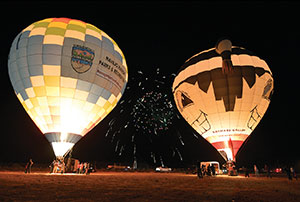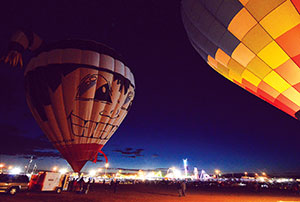Parks and Rec looking for first Native balloon pilot

(Times photo - Donovan Quintero)
By Antonio Ramirez
Navajo Times
WINDOW ROCK, Sept. 12, 2013


(Times photo – Donovan Quintero)
Top: A series of fireworks burst in the night sky as hot air balloons from the Navajo Parks & Recreation and Koshare set the scene Friday night during the Balloon Glow at the 67th annual Navajo Nation Fair in Window Rock.
The spectacle of two 300-pound hot air balloons stationed on the fairgrounds caught the attention of guests who were able to stand in the balloons' baskets while the pilots actuated the burners. Ten-foot-high flames shot straight into the envelope of the balloons, lifting them slightly off the ground.
When this was done the blue-orange flames illuminated the darkness and people inside the baskets could be seen smiling as they cheered for more.
As part of its long-term goal, the Navajo Parks and Recreation Department would like to sponsor an individual student who wants to become a balloon pilot. While the department does not yet have the funds to pay for a student's licensing, the balloon glow event was, in part, designed to initiate the search for a student willing and interested in flying.
"Currently, we have no Navajo pilots - actually, no Native American pilots - in the Southwest," said Geri Hongeva, media representative for the Navajo Parks and Recreation Department and coordinator of the event. "We would like in the next five, 10 years to have one of our youth, have one of our own people be a pilot."
Bill Lee, pilot of the balloon with the Navajo Nation banner, has offered himself as an instructor if the department can find the right candidate.
"I would love to fly myself out of a job. I'd love to see a young Native American student come on board, someone who's enthusiastic about flight, really wants to learn, takes the time to do it, and let them take over the program," said Lee.
In order to become a commercial balloon pilot, which is necessary for anyone who would want to fly the Navajo Nation banner with the Parks and Recreation Department, an individual must first receive a student pilot certificate, then fulfill the requirements for a private pilot license, and finally work towards a commercial license.
According to Lee, a hot air balloon pilot must take into account a number of factors, the primary one being the weather.
"We need calm wind and cool temperatures (to fly). We look for wind at different elevations that steers us where we want to go. Sometimes we don't get that. We just go where the wind takes us," said Lee.
The unpredictability of the wind requires a chase crew in case the balloon takes off in the wrong direction, said Lee. Pilots are vigilant when landing their balloons and scout out at least three landing spots at one time in case the balloon flies past the designated area.
If a pilot does not land in a location easily accessible by the chase crew, the basket, which weighs 600 pounds when fully fueled, and the 300-pound balloon may have to be carried out depending on the weather conditions and amount of fuel in the tanks.
Over a decade-long span of flying, Lee said that he and his crew have had to carry the balloon out by hand once or twice.
For those interested in becoming a certified pilot, and for curious others, the history behind hot air balloons might be of interest.
Over 200 years ago the Montgolfier brothers noticed how ash would float up their chimney and based on their observation they concluded that it was the smoke that made things rise.
To test their theory the two brothers built a paper bag and filled it with smoke. Even though the theory was incorrect the brothers were fortunate because hot air rises, and the smoke coated the interior of the bag. When the temperature of the air inside the makeshift balloon grew warmer than the outside air, the balloon rose.
"It's the oldest form of flight," said Lee. "When man first flew, this is how he flew."
If policymakers are looking for a practical application to compel them to invest in licensing a student, Lee may have a viable answer.
"As big as the Navajo Nation is, it would be great for them to have two or three balloons and take the balloons not only to fairs, but also to the big parks and really promote the Navajo Nation," said Lee. "It's a flying billboard."
He illustrated the difference between a billboard and a hot air balloon by asking the rhetorical question: How many people stop on the side of the road to take a picture of a billboard?
Then he asked: During the balloon glow event, how many people were seen taking pictures of the balloons?
The 40-foot-high, 30-foot-long sign, concluded Lee, could become a huge commercial vehicle for the Navajo Nation.
Contact Antonio Ramirez at news@navajotimes.com.

